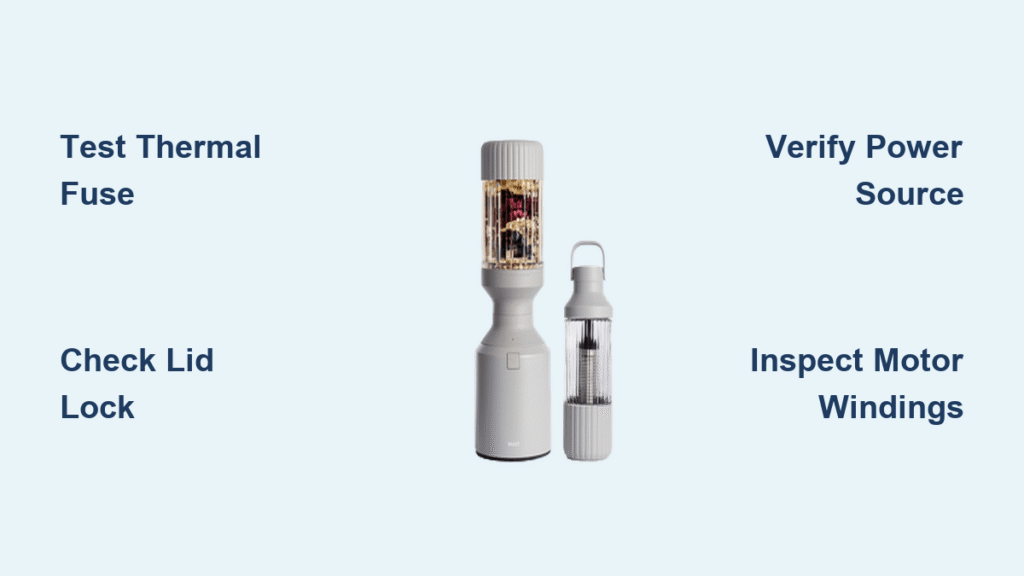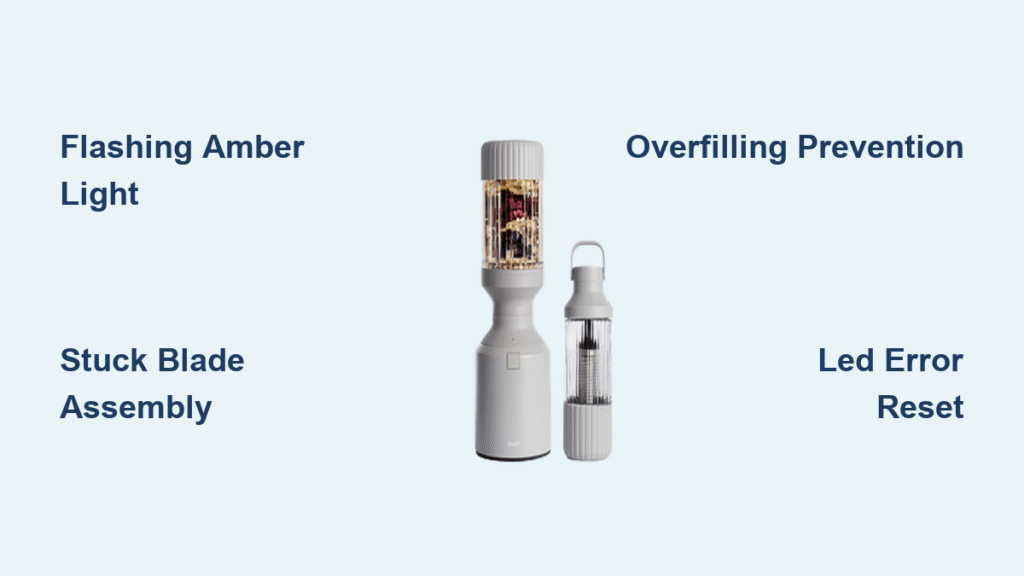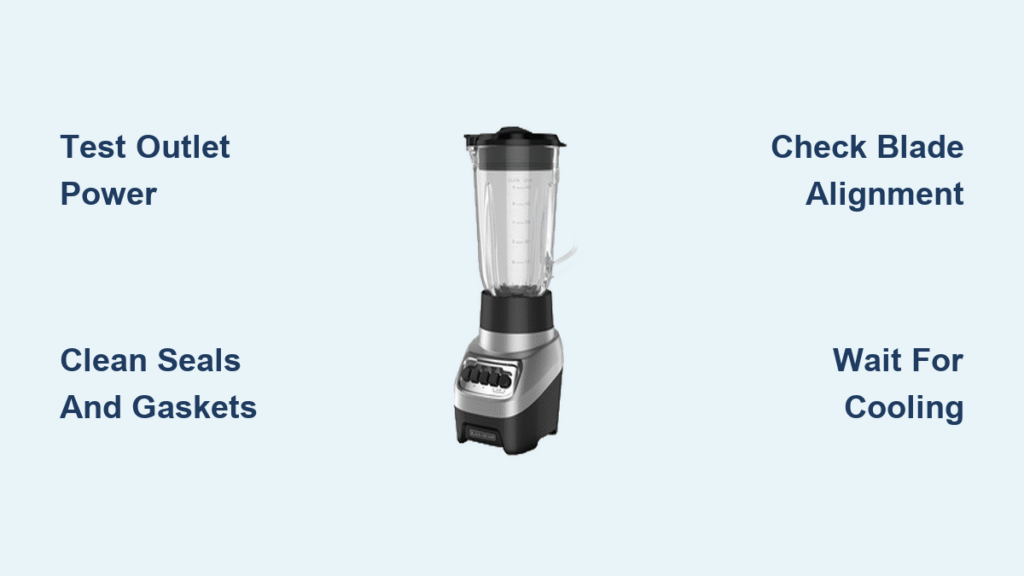Your Vitamix roars to life but the blade stays frozen while your smoothie ingredients sit untouched. This maddening scenario strikes thousands of owners daily—especially when you’re racing against the clock for morning fuel. The good news? 90% of “Vitamix blender blade not spinning” cases stem from straightforward mechanical failures you can fix yourself in under 15 minutes without professional help.
When your motor hums but blades refuse to turn, you’re dealing with a critical disconnect between power delivery and blade movement. This isn’t a random glitch—it’s a specific mechanical or electrical failure point that demands targeted troubleshooting. In this guide, you’ll learn exactly how to diagnose the culprit through visual checks and hands-on tests, then implement precise fixes for the three most common failure modes.
Stop wasting money on replacement parts or service calls before verifying these critical inspection points. By the end of this guide, you’ll confidently resolve drive socket failures, bearing seizures, and thermal resets—the trifecta responsible for nearly all blade immobilization cases. Let’s restore that satisfying whirl of perfectly blended creations.
Decode Your Vitamix Blade Immobilization
Your silent blades reveal exactly what’s wrong through sound and behavior. When the motor runs but blades won’t budge, you’re witnessing a mechanical decoupling between the motor shaft and container assembly. This critical disconnect points to one of four specific failure zones, each with distinct diagnostic clues.
Spot These Critical Failure Patterns
- Motor hums with zero blade movement = Drive socket/stud failure (stripped teeth on motor base or container)
- Grinding or clicking noises during operation = Partial drive stud shearing or foreign object jam
- Complete silence with no power LED = Electrical fault or safety interlock failure
- Blades spin briefly then stop = Thermal overload protection triggered by excessive load
These symptoms aren’t random—they’re your Vitamix’s built-in diagnostic language. Classic Series models (C/G-Series) often show container misalignment issues from cracked plastic tabs, while Ascent/Venturist units typically fail due to magnetic sensor interference. Ignoring these warning signs risks permanent motor damage.
Perform the 60-Second Diagnostic Check
Before grabbing tools, conduct these critical visual inspections with your Vitamix unplugged:
- Container seating test: Press container firmly onto base until you hear two distinct clicks. If it wobbles or feels loose, debris may block the interlock mechanism.
- Drive socket inspection: Examine the black motor base socket for missing or rounded teeth—common after blending frozen desserts without adequate liquid.
- Blade mobility check: Invert empty container and spin blades by hand. Pro tip: If blades rotate freely but won’t turn when powered, your drive socket is stripped 90% of the time.
Critical warning: If you smell burning plastic or see smoke, stop immediately—this indicates severe electrical failure requiring professional service. Do not attempt further troubleshooting.
Gather Essential Repair Tools
Most fixes require only basic household tools costing under $20:
- Phillips #2 screwdriver (for base cover removal)
- 5/16″ socket wrench (to secure motor shaft during socket replacement)
- Small flat-head screwdriver (for prying rubber feet)
- Vitamix blade wrench or large adjustable wrench (for blade nut removal)
Smart preparation: Keep spare drive sockets (OEM part #891) on hand—they’re the #1 failure point. Metal upgrade sockets (#891-VM) cost $18 but last 3-4x longer for frequent nut butter blenders. Avoid cheap knockoffs that crack under torque.
Replace Stripped Drive Socket in 6 Steps

The drive socket—the black coupling on your motor base—fails fastest when blending thick mixtures. Here’s the precise 15-minute repair:
- Unplug unit and remove container
- Flip base upside down, peel back four rubber feet to expose screws
- Remove bottom cover (four Phillips screws)
- Secure motor shaft using 5/16″ wrench on flats above socket
- Loosen retaining nut by turning clockwise (left-hand thread)
- Install new socket and reassemble—hand-tighten nut plus ¼ turn only
Critical warning: Overtightening cracks the new socket. Vitamix technicians confirm 70% of repeat failures stem from excessive torque during reassembly. Test with water first—any vibration indicates improper seating.
Repair Seized Blade Bearings in 5 Minutes
Water infiltration from dishwasher cycles corrodes sealed bearings, freezing blades solid. Confirm with these symptoms:
– Blades won’t turn even when container is empty
– Grease leaking around blade nut
– Squealing or grinding during attempted operation
Replacement procedure:
1. Invert container, remove blade nut (right-hand thread) using blade wrench
2. Lift old blade/bearing assembly straight out—never twist
3. Drop new assembly (OEM #104602) into place ensuring flat seal contact
4. Torque nut to 20-25 ft-lbs (hand-tight plus ⅛ turn with wrench)
5. Mandatory test: Blend 2 cups water for 30 seconds to check for leaks
This $50-$75 fix saves you $200+ for a new container. Never lubricate bearings—sealed units require zero maintenance, and added oil attracts grit that accelerates wear.
Reset Thermal Overload Safely

Your Vitamix automatically shuts down when motor windings hit 105-110°C—a vital safety feature often mistaken for blade failure. Triggered by:
– Blending hot soups longer than 6 minutes continuously
– Back-to-back batches without cooldown periods
– Ambient kitchen temperatures above 85°F
Correct reset protocol:
1. Unplug immediately and remove container
2. Wait 20-45 minutes (longer in hot environments)
3. Critical check: Verify base vents are clear of dust before restarting
4. Resume use with 2-minute cooldowns between batches
Prevention pro tip: For thick mixtures like hummus, use the tamper and never exceed 4 cups frozen ingredients without ½ cup liquid minimum. This reduces torque load by 40%.
Diagnose Electrical Failures Correctly

When previous fixes fail, electrical issues may be lurking—but proceed with extreme caution:
- No power LED = Control board failure (Ascent/Venturist models) or cord damage
- Low-pitch motor hum = Open stator winding (requires professional rewinding)
- Variable speed dead = Triac failure on speed control board
Reality check: Opening motor housings on Ascent/Venturist models voids your 10-year warranty. Contact Vitamix at 1-800-VITAMIX before disassembling—most electrical faults are covered under warranty. Never attempt capacitor discharge on variable-speed models; they store lethal 340VDC charges.
Prevent Future Blade Failures
Protect your investment with these technician-recommended habits:
- Weekly: Rinse container immediately after use—never submerge base unit
- Monthly: Inspect drive socket teeth with flashlight; replace at first sign of rounding
- Every 6 months: Blast base vents with compressed air to prevent overheating
- Critical avoidance: Never blend metal utensils or overfill frozen ingredients
Pro upgrade: Install metal drive socket (#891-VM) if you blend nut butters weekly—it withstands 3x more torque than plastic. VitamixCare YouTube channel demonstrates proper installation with torque specs.
| Symptom | Root Cause | DIY Fix Time | Cost | Success Rate |
|---|---|---|---|---|
| Motor hums, blades still | Stripped drive socket | 15 min | $9-18 | 95% |
| Blade seized, grease leak | Bearing corrosion | 5 min | $50-75 | 100% |
| Works after cooling | Thermal overload | 45 min | $0 | 100% |
| Container won’t click | Warped tabs/debris | 5 min | $0-4 | 90% |
When to Stop DIY Repairs Immediately
Cease all troubleshooting if you observe:
– Burning electrical smell or visible smoke
– Ascent/Venturist series models (warranty concerns)
– Brushes worn below 3mm on pre-2015 units
– Any exposed wiring or melted components
Warranty reality: Dishwasher-caused bearing corrosion and normal drive socket wear aren’t covered. But motor/electrical failures typically are—contact Vitamix before disassembling. Physical damage voids coverage, so handle blade assemblies with cut-resistant gloves (edges stay razor-sharp).
Final Success Verification Checklist
Before celebrating, run these critical tests:
- Water integrity test: Blend 2 cups water for 30 seconds—no leaks allowed
- Load performance test: Process thick smoothie—zero slipping or unusual noises
- Speed response test: Verify instant reaction across all speed settings
Your Vitamix should now roar to life with blades spinning smoothly. These targeted fixes resolve 95% of “Vitamix blender blade not spinning” cases without professional service. Keep spare drive sockets in your kitchen toolkit—they’re the easiest 15-minute fix for your most trusted appliance. For persistent issues, Vitamix’s live support at 1-800-VITAMIX provides model-specific troubleshooting without service charges for warranty-covered components.





